

In 2012, more than 19 million children and adolescents age 20 years and younger received treatment in medical centers, physicians’ office, and hospitals for a condition that included a musculoskeletal related condition. More than two in three visits/discharges (68%) were for the treatment of traumatic injuries, a number that excludes sports injuries not based on diagnosis codes and likely already included in traumatic injuries. The second most common diagnosis is a pain syndrome, accounting for more than 1 in 10 visits (13%). Pain syndromes include amplified musculoskeletal pain, juvenile primary fibromyalgia syndrome, reflex sympathetic dystrophy, benign hypermobility syndrome, and benign limb pains. The third most frequent diagnosis is deformity, accounting for just over 9% of all visits. (Reference Table 7.1.1 PDF [1] CSV [2])
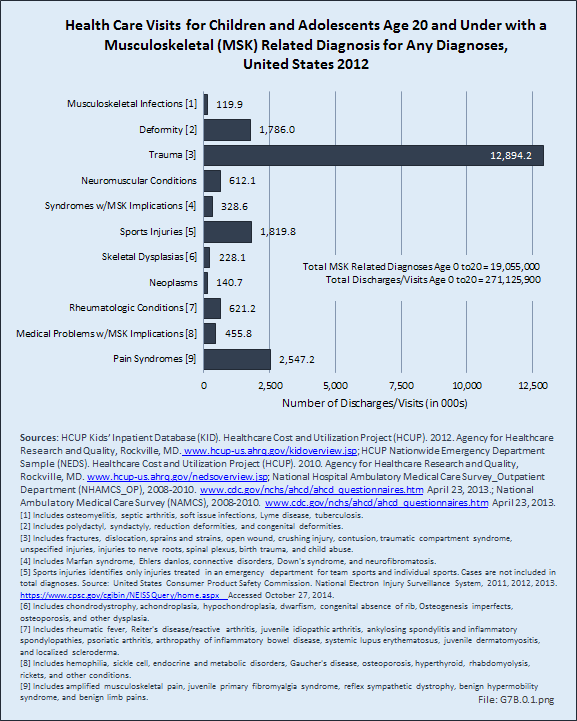
More than one-half (57%) of visits by children and adolescents for a condition that included a musculoskeletal-related condition were to physicians’ offices. Hospital discharges accounted for less than 3% of total visits. Health care visits that included a musculoskeletal-related condition represented 7% of visits made by children and adolescents for any reason, but were nearly 16% of all visits to the emergency department. (Reference Table 7.1.1 PDF [1] CSV [2])
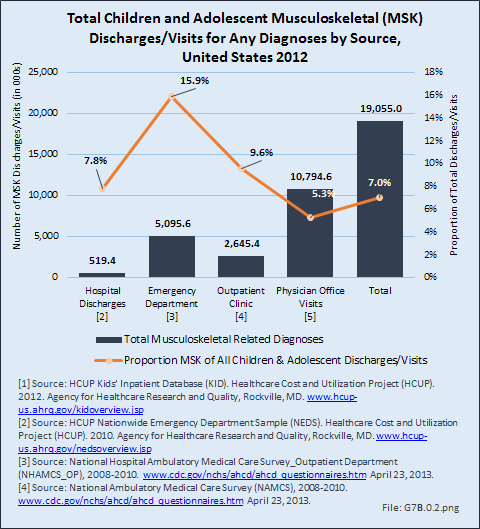
Of the 19 million health care visits by children and adolescents in 2012, 15.6 million had a primary diagnosis of a musculoskeletal-related condition. The greater proportion (75%) were for the treatment of traumatic injuries, again excluding sports injuries. The second and third most common primary diagnosis remained a pain syndrome (11%) and deformity (6%). Although other musculoskeletal related conditions accounted for 3% or fewer of total health care visits for a musculoskeletal-related condition, they nevertheless remain serious health concerns for children and adolescents. (Reference Table 7.1.2 PDF [3] CSV [4])
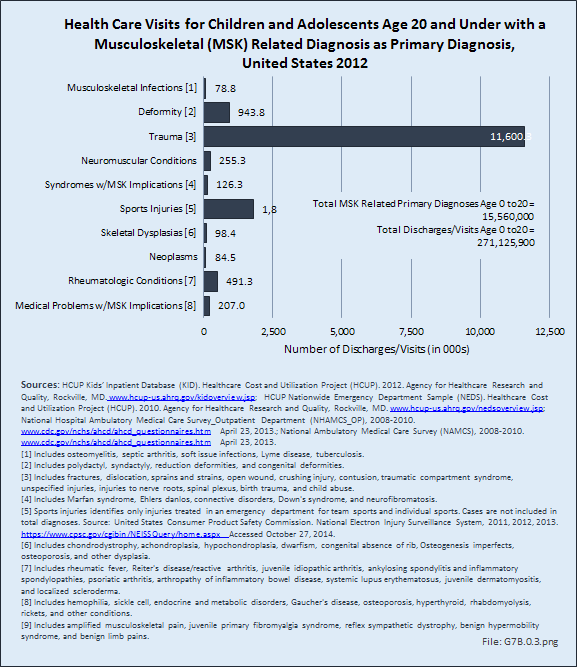
Again, the majority of visits were to physicians’ offices (57%), while visits to an emergency department with a primary musculoskeletal-related condition diagnosis accounted for 28% of visits. Hospital discharges accounted for less than 1% of total visits with a primary musculoskeletal diagnosis. Health care visits that included a primary diagnosis of a musculoskeletal-related condition represented 6% of visits made by children and adolescents for any reason, but were 14% of all visits to the emergency department. (Reference Table 7.1.2 PDF [3] CSV [4])
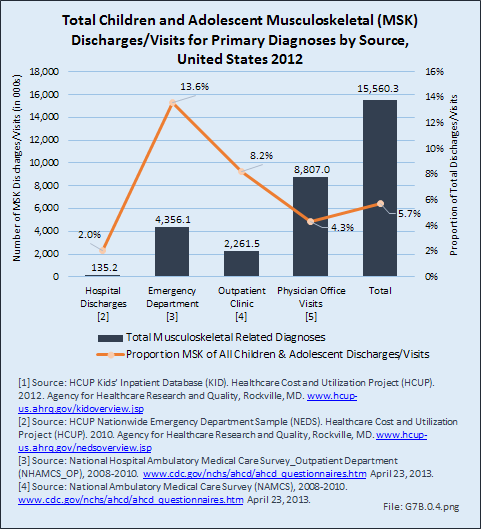
Musculoskeletal infections were diagnosed in 119,900 children and adolescent health care visits in 2012, of which 78,800 had a primary diagnosis of musculoskeletal infection. Of this total, 14,900 children and adolescents were hospital discharges, with 9,100 hospitalizations for a primary diagnosis of a musculoskeletal infection. (Reference Table 7.1.1 PDF [1] CSV [2] and Table 7.1.2 PDF [3] CSV [4])
Males were more likely to be hospitalized with a musculoskeletal infection than females, as were children between the ages of 1 and 10 years. Musculoskeletal infections as a primary diagnosis accounted for 1.8% of hospital discharges for any musculoskeletal-related condition, but only 0.1% of hospital discharges for all health care reasons for children and adolescents age 20 years and younger. (Reference Table 7.2 PDF [5] CSV [6])
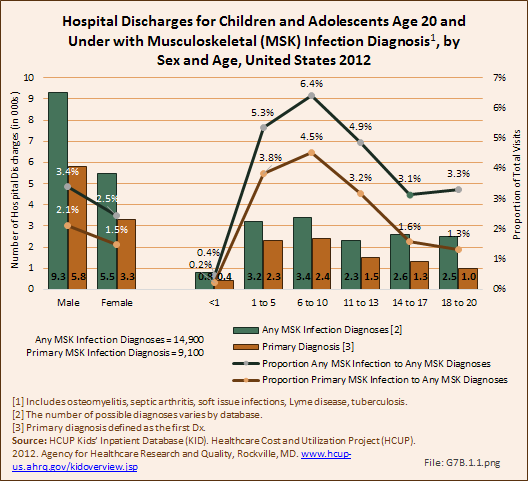
Total charges averaged $70,700 for a mean 8.5-day stay when children and adolescents were hospitalized with a diagnosis of musculoskeletal infection along with other medical conditions. With a primary diagnosis of infection, the stay was shorter (6.3 days), and mean charges were $46,000. Total hospital charges for all primary musculoskeletal infection discharges in 2012 were $419 million. (Reference Table 7.2 PDF [5] CSV [6])
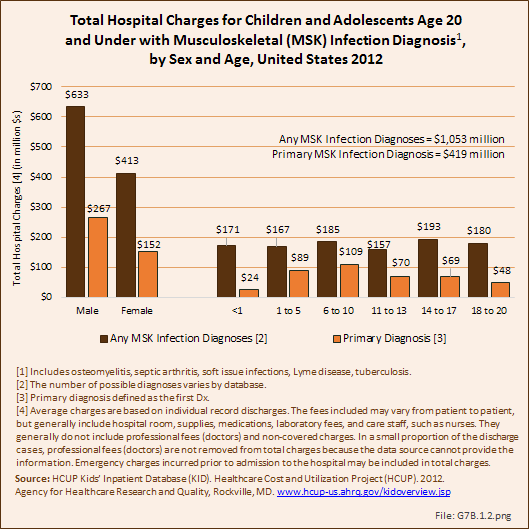
Deformity in children and adolescents was subdivided into five sections: upper extremity, lower extremity, hip and pelvis, spine, and other/unspecified.
Upper extremity deformity includes diagnoses such as polydactyly, syndactyly, reduction deformities such as amelia and longitudinal deficiencies of the upper extremity, and other congenital deformities such as synostosis, Madelung deformity, and Apert syndrome. A complete listing of deformity codes can be found by in the ICD-9-CM Child and Adolescents Codes [7].
Lower extremity deformity includes diagnoses such as polydactyly, syndactyly, reduction deformities such as amelia and longitudinal deficiencies of the lower extremity, genu varum, genu valgum, and other congenital developmental deformities such as clubfoot and flatfoot.
Hip and pelvis deformity includes diagnoses such as coxa valga, coxa vara, slipped capital femoral epiphysis, pelvic deformity, Legg Calves Perthes disease, and developmental dysplasia of the hip.
Spine deformity includes anomalies of the spinal cord such as syringomyelia and diastomatomyelia, as well as deformities of the vertebral column such as scoliosis, kyphosis, spondylolysis, spondylolisthesis, and congenital spinal anomalies.
Other and unspecified deformities include deformities of the chest wall such as pectus excavatum and pectus carinatum, as well as nonspecific deformity diagnoses.
Musculoskeletal deformities were diagnosed in 1.8 million children and adolescent health care visits in 2012, of which 943,800 had a primary diagnosis of musculoskeletal deformity. Among the total with any diagnoses of deformity, 111,800 children and adolescents were hospital discharges, with 30,100 hospitalizations for a primary diagnosis of a musculoskeletal infection. (Reference Table 7.1.1 PDF [1] CSV [2] and Table 7.1.2 PDF [3] CSV [4])
Females had a slightly higher rate of overall deformity diagnoses with hospitalization, and accounted for 55% of primary diagnosis hospitalizations. Children under the age of 1 year had a high rate of musculoskeletal deformity for any diagnosis with hospitalization (41%), but accounted for only 5% of primary hospitalizations. Primary diagnosis of musculoskeletal deformity with hospitalization increased with age.
Musculoskeletal deformity as a primary diagnosis accounted for 6% of hospitalizations for any musculoskeletal condition diagnosis, but only 0.5% of hospitalizations for any health care reasons for children and adolescents age 20 years and under. (Reference Table 7.3 PDF [8] CSV [9])
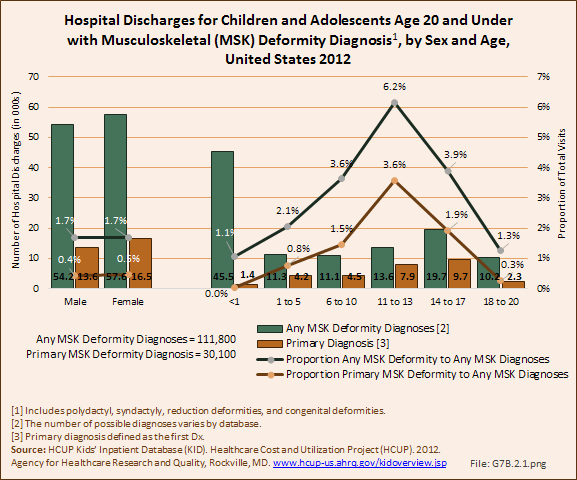
Deformity of the spine represented the largest share of hospitalizations (42%), followed by the lower extremity at 29% and upper extremity at 18%.
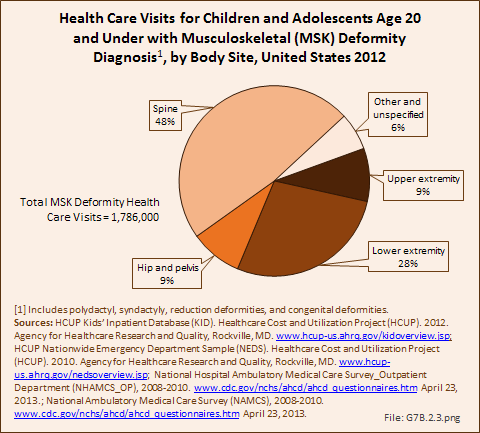
Total charges averaged $69,300 for a mean 6.4-day stay when children and adolescents were hospitalized with a diagnosis of musculoskeletal deformity along with other medical conditions. With a primary diagnosis of deformity, the stay was shorter (4.1 days), but mean charges were much higher at $94,500, primarily due to the higher charges for children and adolescents age 11 years and older. Total hospital charges for all primary musculoskeletal deformity discharges in 2012 were $2.84 billion. (Reference Table 7.3 PDF [8] CSV [9])
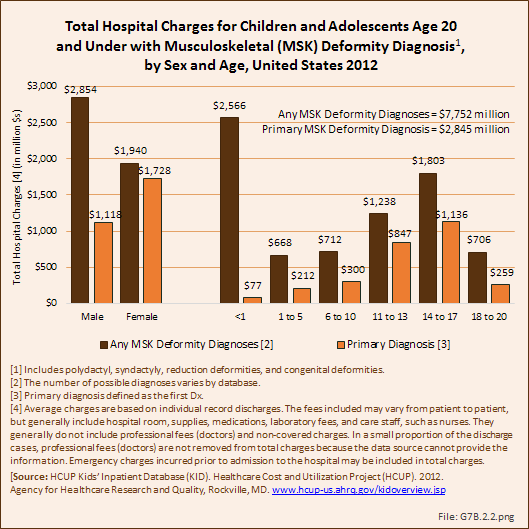
Trauma resulting in musculoskeletal injury was diagnosed in 12.9 million children and adolescent health care visits in 2012, of which 90% (11.6 million) had a primary diagnosis of musculoskeletal injury. Only a small number were serious enough to require hospitalization. Among any trauma musculoskeletal injury diagnoses, 226,700 children and adolescents were hospitalized, with 76,600 hospitalized with a primary diagnosis of a musculoskeletal injury. (Reference Table 7.1.1 PDF [1] CSV [2] and Table 7.1.2 PDF [3] CSV [4])
Males had nearly double the injury rates with hospitalization of females for both any diagnoses or as a primary diagnosis. Hospitalization for musculoskeletal injuries were greater between the ages of 1 and 10 years than for the middle ages of 11 to 13 years. However, they were highest for the oldest adolescents, age 14 years and older. Children under the age of one year had a high rate of musculoskeletal injury for any diagnosis with hospitalization, primarily due to a diagnosis of birth trauma, and reflected in the much lower rate of hospitalization with a primary trauma diagnosis.
Musculoskeletal injury as a primary diagnosis accounted for 15% of hospitalizations for any musculoskeletal condition diagnosis, and 1.1% of hospitalizations for any health care reasons for children and adolescents age 20 years and younger. For all but the youngest age (under 1 year), which is skewed by birth trauma, trauma accounted for 20% to 25% of all hospitalization for any musculoskeletal diagnoses. (Reference Table 7.4 PDF [10] CSV [11])
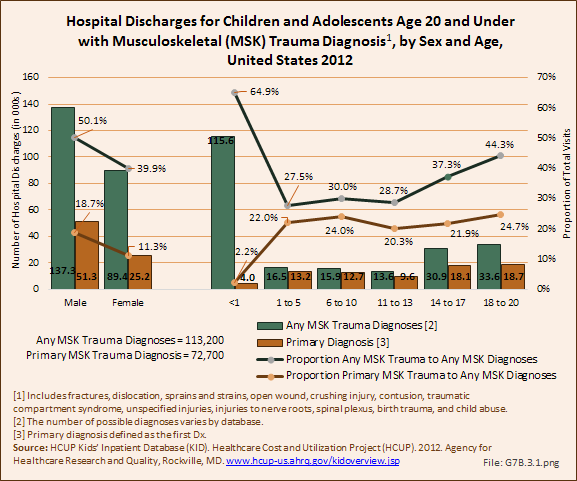
Trauma to the upper extremity account for nearly half (49%) of all trauma health care visits by children and adolescents. This was followed closely by lower extremity trauma (37%). Spine and trunk injuries were 8%, with hip and pelvis at 3%. Birth trauma was 1.5% of all health care visits, but accounted for nearly half (48%) of hospital discharges for musculoskeletal trauma diagnoses. Child abuse was reported in 1% of all health care visits for trauma. Trauma to multiple sites was cited in about 2% of cases. (Reference Table 7.1.1 PDF [1] CSV [2])
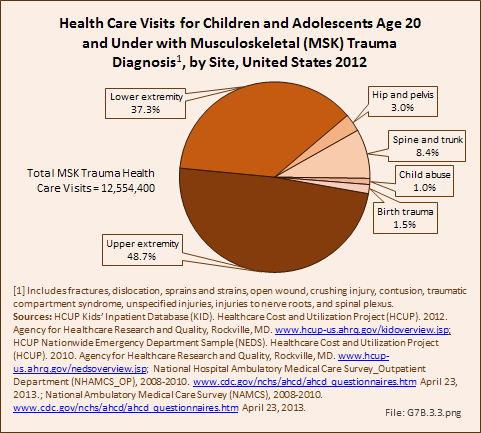
Total charges averaged $35,400 for a mean 4.2-day stay when children and adolescents were hospitalized with a diagnosis of musculoskeletal injury along with other medical conditions. With a primary diagnosis of injury, the stay was shorter (3.2 days), but mean charges were higher at $43,700, likely due to the high number of birth trauma cases. Mean charges were highest for adolescents of high school age or older (14 to 20 years). Total hospital charges for all primary musculoskeletal injury discharges in 2012 were $3.35 billion. (Reference Table 7.4 PDF [10] CSV [11])
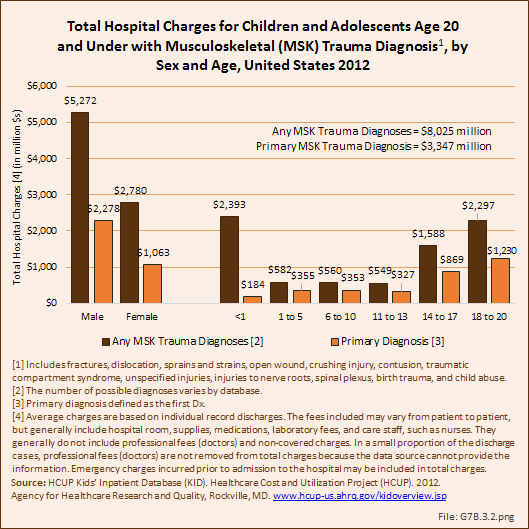
Neuromuscular conditions were diagnosed in 612,100 children and adolescent health care visits in 2012, of which 255,300 had a primary diagnosis of a neuromuscular condition. About 1 in 10 (11%) children and adolescents with any neuromuscular diagnoses were hospitalized (67,200), but fewer than 2% (4,500) with a primary neuromuscular diagnosis had a hospital discharge. (Reference Table 7.1.1 PDF [1] CSV [2] and Table 7.1.2 PDF [3] CSV [4])
Males were more likely to be hospitalized than females for both any neuromuscular diagnoses or as a primary diagnosis. Children ages 6 to 10 years had the highest rate of hospitalization, both with any diagnoses and as a primary diagnosis. Rates of hospitalization declined as children age.
Neuromuscular conditions as a primary diagnosis accounted for about 1.5% of hospitalizations for any musculoskeletal condition diagnosis and only 0.1% of all hospitalizations for any health care condition. (Reference Table 7.5 PDF [12] CSV [13])
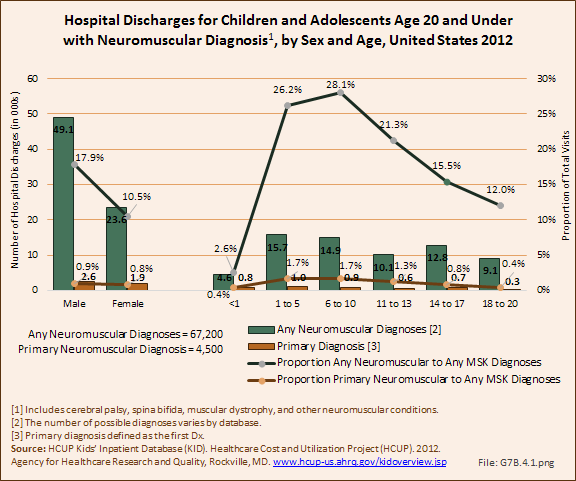
Cerebral palsy was diagnosed in two-thirds (66%) of hospital discharges. Spina bifida and muscular dystrophy represented 18% and 8% of discharges, respectively.
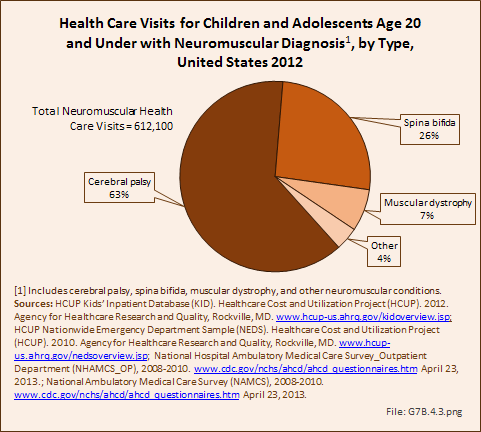
Total charges averaged $69,500 for a mean 6.7-day stay when children and adolescents were hospitalized with a diagnosis of a neuromuscular condition along with other medical conditions. With a primary neuromuscular diagnosis, the stay was longer (7.5 days), and mean charges were higher at $84,000. Mean charges and length of stay were highest for the youngest patients, those under 1 year of age. Total hospital charges for all primary neuromuscular discharges in 2012 were $378 million. (Reference Table 7.5 PDF [12] CSV [13])
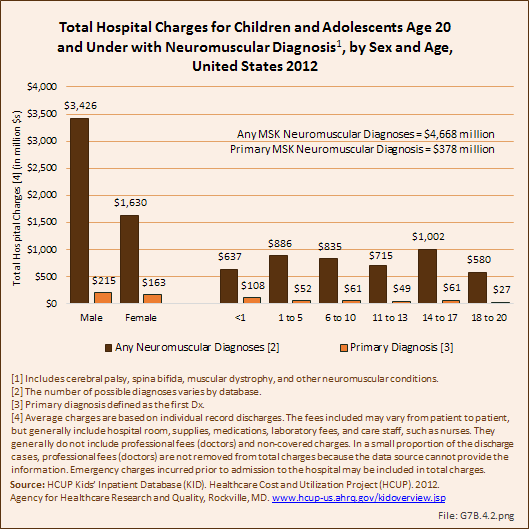
Syndromes with musculoskeletal implications were diagnosed in 328,600 children and adolescent health care visits in 2012, of which 126,300 had a primary diagnosis of a syndrome condition. About 1 in 10 (9%) children and adolescents with any syndrome with musculoskeletal implications diagnoses were hospitalized (29,800), but less than 1% (600) with a primary diagnosis of a syndrome with musculoskeletal implications had a hospital discharge. (Reference Table 7.1.1 PDF [1] CSV [2] and Table 7.1.2 PDF [3] CSV [4])
Males, more than females, had a hospital discharge with any syndrome with musculoskeletal implications diagnoses. Infants and young children under the age of 5 years had the highest rate of hospitalization for any diagnoses of syndromes with musculoskeletal implications. The number of hospitalizations with a primary diagnosis was too small for analysis by sex and age.
Any diagnoses of syndromes with musculoskeletal implications accounted for 6% of hospitalizations for any musculoskeletal condition diagnosis, and 0.4% of all hospitalizations for any health care condition. Hospitalizations with a primary diagnosis were 0.1% of all musculoskeletal diagnoses. (Reference Table 7.6 PDF [14] CSV [15])
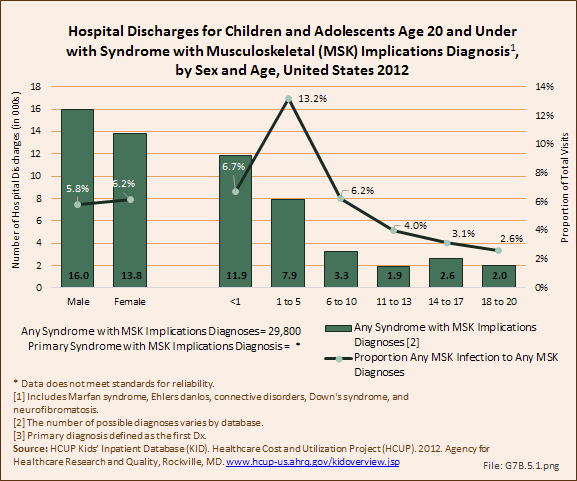
Total charges averaged $75,100 for a mean 8.1-day stay when children and adolescents were hospitalized with a diagnosis of a syndrome with musculoskeletal implications condition along with other medical conditions. With a primary syndrome diagnosis, the stay was slightly longer (8.7 days), and mean charges were higher at $100,800. Mean charges and length of stay were highest for the youngest patients, those under 1 year of age. Total hospital charges for primary syndrome with musculoskeletal implications discharges in 2012 were $60.5 million. (Reference Table 7.6 PDF [14] CSV [15])
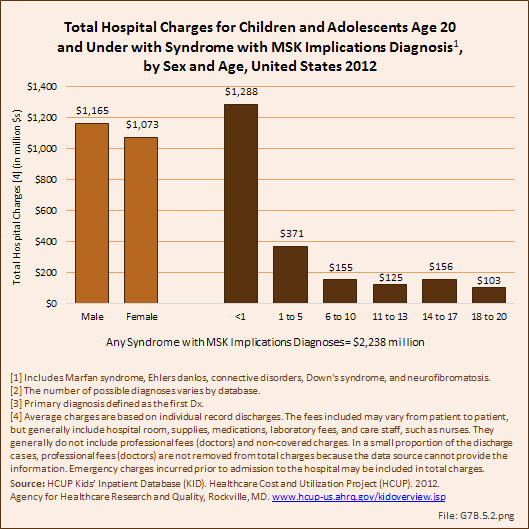
On average across the years from 2011 to 2013, 1.8 million injuries per year related to team or individual sport activities occurred to children and adolescents age 20 years and younger. Data reported is from consumer product-related injuries occurring in the United States from a statistically valid sample of emergency departments collected by the United States Consumer Product Safety Commission, National Electronic Injury Surveillance System. Data shown for sports injuries are not included in the overall total for musculoskeletal conditions among children and adolescents, on the assumption it duplicates numbers found in the emergency department database based on ICD-9-CM codes and used in the trauma injuries [18] section.
Males report injuries at twice the number as females, with the highest number of injuries occurring in the junior high (11 to 13 years) and high school (14 to 17 years) ages. (Reference Table 7.7.1 PDF [19] CSV [20])
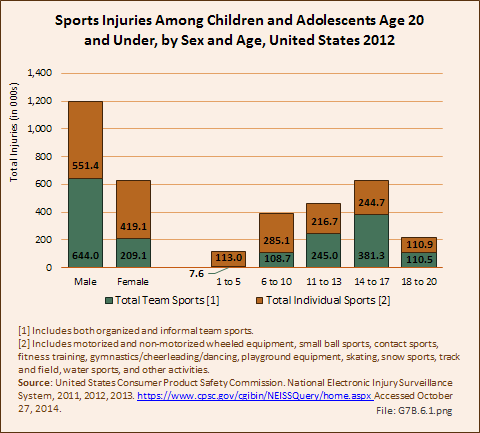
Team sports, both organized and informal, accounted for just under one-half (47%, or 853,100 injuries) of all sports-related injuries reported. Basketball had the highest number of team sport related injuries at 33%, and was closely followed by football at 32%.
Team sport injuries to males were three times the number reported for females. The only sport in which female injuries outnumber male injuries is volleyball. Nearly half (45%) of team sport injuries to children and adolescents occurred during the high school years (age 14 to 17 years), with another 28% in the junior-high age range of 11 to 13 years. (Reference Table 7.7.1 PDF [19] CSV [20])
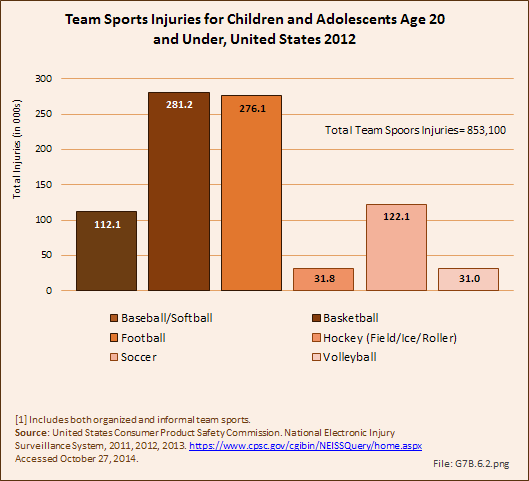
The most common musculoskeletal injury incurred was a sprain or strain, accounting for 46% of team sport injuries. Volleyball had the highest proportion of sprains and strains, followed by basketball. Baseball led in contusion injuries, while fractures occurred most frequently in football, hockey (including field, ice, and roller hockey), and soccer. (Reference Table 7.7.2 PDF [21] CSV [22])
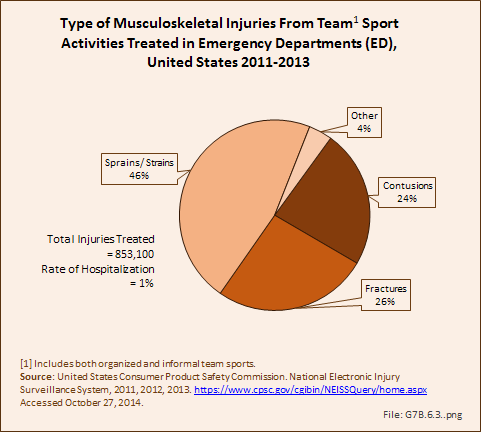
Only 1% of team sport injuries were serious enough to result in hospitalization.
Individual sports injuries accounted for 53% of total injuries reported (970,500). One in five injuries occurred while riding bicycles or other nonmotorized wheeled equipment such as tricycles and scooters. These injuries occurred most frequently to children ages 6 to 10 years, but were common at all ages. Injuries on playground equipment were the second highest type of individual sport injuries, accounting for 15% of all injuries. Playground equipment injuries occurred almost exclusively to children age 10 years or younger. Skating injuries, which includes roller and ice skates, inline skates, and skateboards, were the cause of 11% of individual sport injuries.
Females accounted for a larger share of individual sport injuries (43%) than in team sports. Still, the only activity in which females had a significantly higher number of injuries than males was in gymnastics/cheerleading/dancing. (Reference Table 7.7.1 PDF [19] CSV [20])
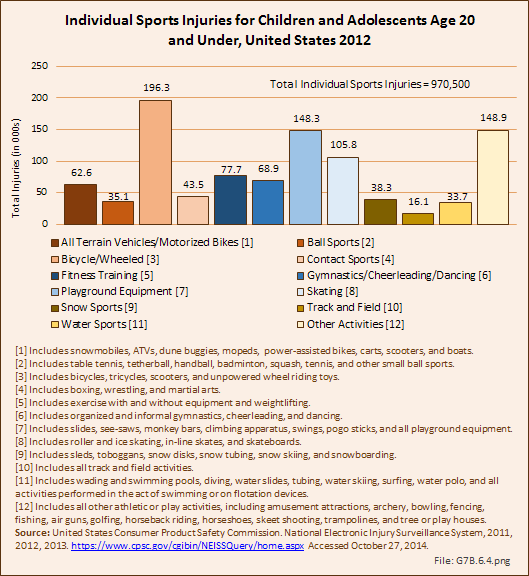
Fractures and sprains/strains each accounted for one-third of all individual sport activity injuries. However, the type of musculoskeletal injury varied substantially with the type of activity. Fractures resulted from playground equipment injuries one-half the time, and there were a higher share of fractures in snow sports and skating injuries as well. Sprains/strains occurred in two-thirds of track and field injuries, and there were a higher share of sprains/strains occurring in gymnastics/cheerleading/dancing and fitness training injury category as well. The most common type of injury reported from bicycle/wheeled equipment were contusions. (Reference Table 7.7.2 PDF [21] CSV [22])
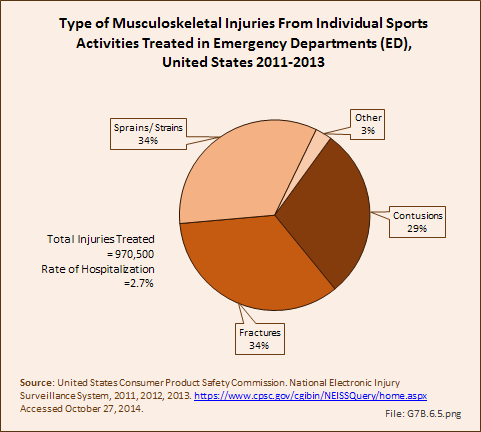
Nearly 3% of individual sport injuries resulted in hospitalization.
Skeletal dysplasias, also referred to as osteochondrodysplasias, are a heterogeneous group of disorders that affect the growth and development of bone and cartilage. There is great variability of severity and involvement ranging from neonatal lethality to mild growth differences noted incidentally in adulthood. Hundreds of such dysplasias have been described but most are so rare that true incidence is difficult to estimate.1 The most common diagnoses included in this category are achondroplasia, hypochondroplasia, pseudoachondroplasia, multiple epiphyseal dysplasia, diastrophic dysplasia, multiple hereditary exostosis, enchondromatosis, osteogenesis imperfecta, and osteopetrosis. The overall incidence of skeletal dysplasias is two to five per 10,000 live births.2 Despite their relative rarity, many patients with these disorders require extensive medical and surgical treatments throughout their childhood and into adulthood.
Because of the rarity of skeletal dysplasias, data on health care visits for these conditions is too small to be reported.
Pediatric musculoskeletal neoplasms are relatively rare. They can be categorized as either benign or malignant, as has been done for this document. Musculoskeletal neoplasms are often also categorized by the type of tissue they produce or from which they are derived.
The most common types of tumors that affect the musculoskeletal system by tissue type are cysts, bone-producing tumors, cartilage tumors, fibrous tumors, soft tissue tumors, and peripheral neuroectodermal tumors. Most benign tumors, such as nonossifying fibromas, result in little or no disability and require no treatment. Other benign tumors may require surgical intervention. Painful or prominent osteochondromas may require surgical excision. Simple bone cysts can weaken the bone and increase fracture risk, and may require surgery treatment in order to resolve the cyst and prevent fracture. Other benign tumors include lipomas, fibrous dysplasia, enchondromas, osteoid osteoma, and osteoblastomas.
The most common malignant tumors of the pediatric musculoskeletal system are osteosarcoma, Ewing sarcoma/peripheral neuroectodermal tumor, rhabdomyosarcoma, and synovial cell sarcoma. Osteosarcoma is the most common malignant bone tumor in patients under 20 years of age, with an incidence of around 29 per 1 million people. Ewing sarcoma is the second most common pediatric malignant musculoskeletal tumor and is part of the Ewing family of tumors, which includes peripheral neuroectodermal tumors. Most of the tumors in the family have the genetic translocation.1 Long-term survival of patients with both of these tumors has drastically improved with the routine use of adjuvant chemotherapy.
For additional information on musculoskeletal tumors in children you can refer to the Tumors [23] section of this report.
Neoplasms, including both benign and malignant, were diagnosed in 140,700 children and adolescent health care visits in 2012, of which 84,500 had a primary diagnosis of a neoplasm. About one in five (18%) of children and adolescents with any neoplasm diagnoses were hospitalized (25,600), but fewer than 5% (4,000) with a primary diagnosis of a neoplasm had a hospital discharge. (Reference Table 7.1.1 PDF [1] CSV [2] and Table 7.1.2 PDF [3] CSV [4])
Slightly more males than females had a hospital discharge with any or a primary neoplasm diagnosis. As children age, there is a higher incidence of neoplasm prevalence resulting in hospitalization.
Any diagnoses of neoplasm accounted for 5% of hospitalizations for any musculoskeletal condition diagnosis, and 0.4% of all hospitalizations for any health care condition. Hospitalizations with a primary diagnosis of neoplasm were 0.8% of all musculoskeletal diagnoses and 0.1% of hospitalizations for any health condition diagnosis. (Reference Table 7.8 PDF [24] CSV [25])
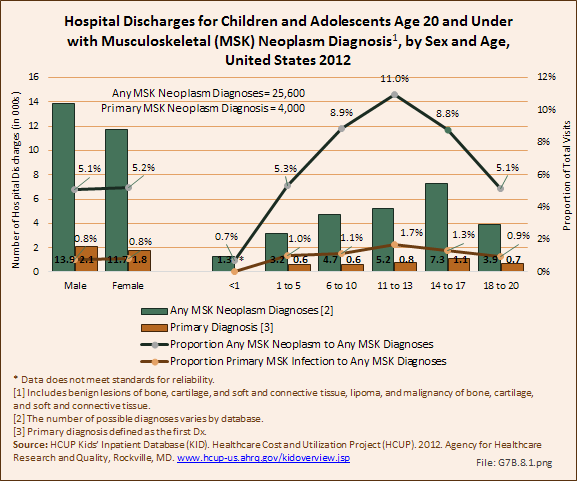
Neoplasm diagnoses are divided equally between benign and malignant neoplasm for any diagnoses and all sources, but 86% of hospitalized diagnoses are malignant.
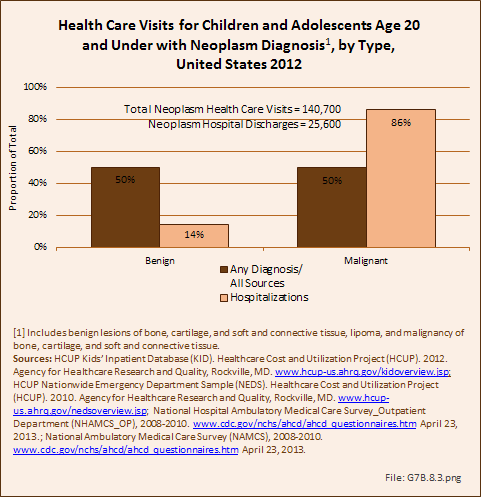
Total charges averaged $46,900 for a mean 4.6-day stay when children and adolescents were hospitalized with any diagnosis of neoplasm along with other medical conditions. With a primary neoplasm diagnosis, the stay was slightly longer (6.2 days), and mean charges were higher at $84,100. Mean charges and length of stay were highest for children ages 14 to 17 years, but the increase rose steadily from the youngest patients. Total hospital charges for primary neoplasm diagnosis discharges in 2012 were $336.3 million. (Reference Table 7.8 PDF [24] CSV [25])
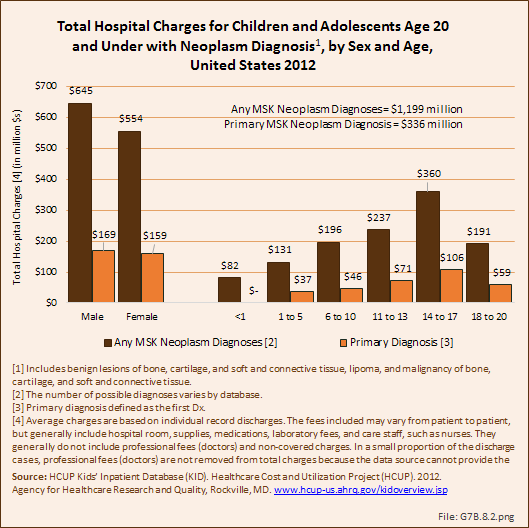
An estimated 300,000 children in the Unites States are diagnosed with juvenile arthritis or another chronic rheumatologic condition such as systemic lupus erythematosus, juvenile dermatomyositis, or linear scleroderma.1 These chronic musculoskeletal conditions generally require chronic care, and without appropriate treatment can lead to significant disability.
Juvenile idiopathic arthritis (JIA) (formally called juvenile rheumatoid arthritis [JRA] or juvenile chronic arthritis [JCA]) is estimated to affect 1 in 1,000 children in the United States.2 JIA is diagnosed in a child younger than 16 years of age with at least six weeks of persistent arthritis. There are seven distinct subtypes, each having a different presentation and association to autoimmunity and genetics.3 Certain subtypes are associated with an increased risk of inflammatory eye disease (uveitis). Understanding the differences in the various forms of JIA, their causes, and methods to better diagnose and treat these conditions in children is important to future treatment and prevention. Among all subtypes, approximately half of children with JIA still have active disease after 10 years.4
There are several other causes of acute or chronic arthritis in children that do not meet the diagnostic criteria of JIA, including, but not limited to, rheumatic fever, Reiter syndrome/reactive arthritis, and the arthritis associated with inflammatory bowel disease.
Approximately 15% to 20% of cases of systemic lupus erythematosus (SLE) in the United States occur in children younger than 18 years of age. SLE is a chronic autoimmune condition characterized by the production of autoantibodies leading to immune complex formation and end organ damage. For reasons that remain unclear, pediatric SLE is associated with increased disease severity, increased short- and long-term morbidity, and mortality as compared to adult-onset SLE.5
Juvenile dermatomyositis is a chronic inflammatory condition characterized by inflammation of the skin and muscle. Estimated incidence of the disease in the United States is 0.5 per 100,000 people; the prevalence is not known.2
The sclerodermatous conditions are defined in part by the common clinical feature of tightening or hardening of the skin. Systemic scleroderma, also called diffuse cutaneous systemic scleroderma, is rare in childhood, accounting for only 2% to 3% of all cases of this condition, which has an estimated prevalence of 24 cases per 100,000 people. Linear scleroderma is the most common subtype of scleroderma diagnosed in the pediatric population. It is characterized by a linear streak of sclerosis typically involving an upper or lower extremity.2
In 2006, the CDC Arthritis Program finalized a case definition for ongoing surveillance of pediatric arthritis and other rheumatologic conditions (SPARC) using the current ICD-9-CM diagnostically -based data systems.6 In response to the variations in conditions that some felt should be included but were not, CDC generated estimates not included in the case definition.
Using the SPARC definitions, rheumatologic conditions were diagnosed in 621,200 children and adolescent health care visits in 2012, of which 491,300 had a primary diagnosis of a rheumatologic condition. Only 2% of children and adolescents with any rheumatologic diagnoses were hospitalized (13,500), while less than 1% (4,200) with a primary diagnosis of a rheumatologic condition had a hospital discharge. The majority of children and adolescents with a rheumatologic condition diagnosis were seen in physicians’ offices. (Reference Table 7.1.1 PDF [1] CSV [2]; and Table 7.1.2 PDF [3] CSV [4])
Females were hospitalized with a rheumatologic condition at nearly three times the rate of males, both for any diagnoses and as a primary diagnosis. As children age, there is a higher incidence of rheumatologic conditions diagnosis.
Any diagnoses of a rheumatologic condition accounted for just under 3% of hospitalizations for any musculoskeletal condition diagnosis, and 0.2% of all hospitalizations for any health care condition. Hospitalizations with a primary diagnosis of a rheumatologic condition were 0.8% of all musculoskeletal diagnoses and 0.1% of hospitalizations for any health condition diagnosis. (Reference Table 7.9 PDF [27] CSV [28])
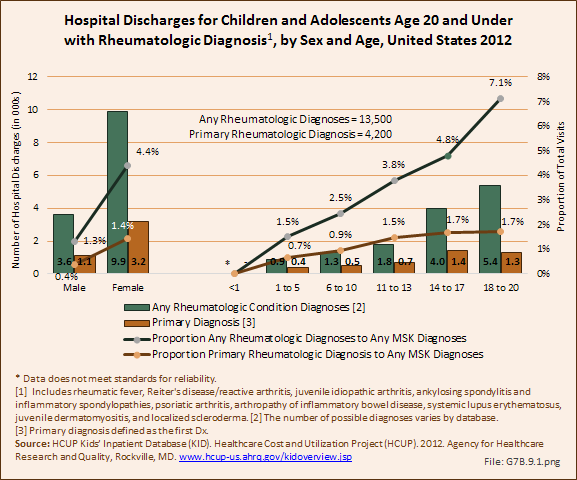
Total charges averaged $46,200 for a mean 5.3-day stay when children and adolescents were hospitalized with any diagnosis of a rheumatologic condition along with other medical conditions. With a primary rheumatologic diagnosis, the stay was about the same (5.1 days), and mean charges only slightly higher at $48,500. Age and sex were not significant factors in length of hospital stay and average charges for a rheumatologic condition diagnosis. Total hospital charges for primary rheumatologic condition diagnosis discharges in 2012 were $203.8 million. (Reference Table 7.9 PDF [27] CSV [28])
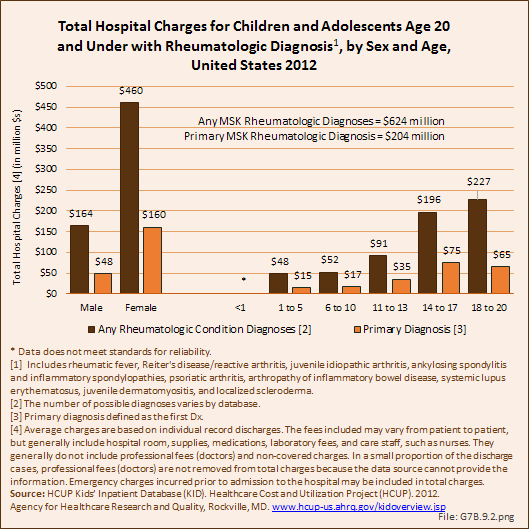
Many medical problems have musculoskeletal implications. This section discusses some of the more common of those diagnoses, including hemophilia, sickle cell disease, and endocrine and metabolic disorders such as rickets and lysosomal storage disorders.
Hemophilia is a genetic disorder characterized by abnormal blood clotting secondary to congenital deficiency of clotting factors VIII and IX. It may result in musculoskeletal problems by way of hemophilic arthropathy and intramuscular hemorrhage. Hemophilic arthropathy occurs through spontaneous bleeding into a weight-bearing joint, resulting in cartilage degeneration and arthrosis as well as asymmetric growth stimulation and deformity.
Sickle cell disease is inherited in an autosomal dominant fashion and is characterized by production of abnormal hemoglobin. This results in reduced oxygen delivery to tissues and can lead to multiple musculoskeletal manifestations, including painful bone infarcts, osteomyelitis, avascular necrosis, and vertebral compression fractures.
Metabolic bone diseases, such as rickets, occur due to abnormal calcium and phosphate metabolism. Rickets occurs in many forms, including vitamin D deficiency, vitamin D resistance, hypophosphatemic rickets, and renal osteodystrophy. Regardless of the cause, the result is inadequate calcification of bone and cartilage, resulting in bone pain and deformity.
The most common lysosomal storage disease is Gaucher’s disease, an autosomal recessive condition characterized by a deficiency in the enzyme beta-glucocerebrosidase. In Gaucher’s disease, there is an accumulation of glucocerebrosides, which contain glucose, in the tissues. This results in musculoskeletal manifestations that include bone deformity secondary to bone marrow infiltration, avascular necrosis, bone pain, pathologic fracture, and osteomyelitis.
Medical problems with musculoskeletal implications were diagnosed in 455,800 children and adolescent health care visits in 2012, of which 45% (207,000) had a primary diagnosis of a medical problem with musculoskeletal implications condition. More than one in ten (12%) children and adolescents with any medical problem diagnoses were hospitalized (55,300), while 2% (4,800) with a primary diagnosis had a hospital discharge. (Reference Table 7.1.1 PDF [1] CSV [2] and Table 7.1.2 PDF [3] CSV [4])
Males and females were hospitalized with a medical problem with musculoskeletal implications in about the same numbers, but with a primary diagnosis, males were more likely to be hospitalized. The highest rate of hospitalization when compared to other MSK conditions, was for adolescents age 18 to 20 years of age, the ages just entering adulthood. However, this age group tends to have a higher rate of musculoskeletal hospitalizations overall.
Any diagnoses of a medical problem with musculoskeletal implications accounted for 11% of hospitalizations for any musculoskeletal condition diagnosis, and less than 1% of all hospitalizations for any health care condition. Hospitalizations with a primary diagnosis of a medical problem were 1% of all musculoskeletal diagnoses and 0.1% of hospitalizations for any health condition diagnosis. (Reference Table 7.10 PDF [29] CSV [30])
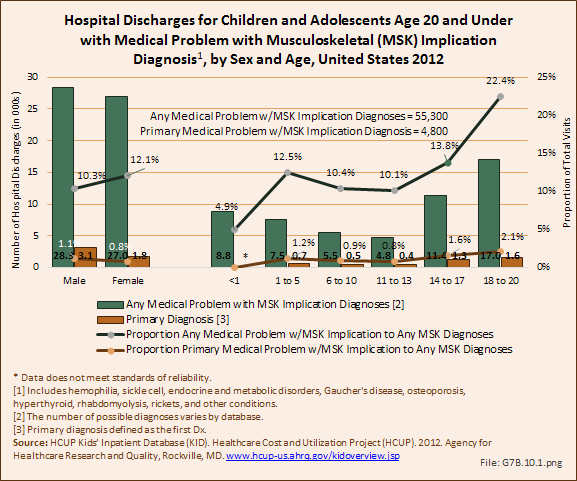
Rickets accounted for 35% of all health care visits for medical problems with musculoskeletal implications, but 69% of the hospitalized cases. (Reference Table 7.1.1 PDF [1] CSV [2])
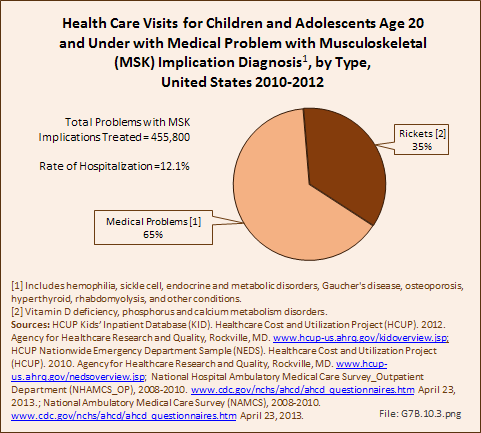
Total charges averaged $112,300 for a mean 11.5-day stay when children and adolescents were hospitalized with any diagnosis of a medical problem with musculoskeletal implications along with other medical conditions. With a primary medical problem diagnosis, the stay was shorter (3.5 days), and mean charges about a fourth that of medical problems as a contributing condition ($31,600).
When hospitalized with any diagnosis of a medical problem with musculoskeletal implications along with other medical conditions, males had slightly longer hospital stays and charges than females did. Infants under the age of 1 year had significantly longer stays and higher charges than other age groups, primarily due to cases of rickets. However, for primary medical diagnoses of musculoskeletal implications along with another medical condition, sex and age were not major factors in length of hospital stay and mean charges. Total hospital charges for primary medical problem with musculoskeletal implications diagnosis discharges in 2012 were $151.7 million. (Reference Table 7.10 PDF [29] CSV [30])
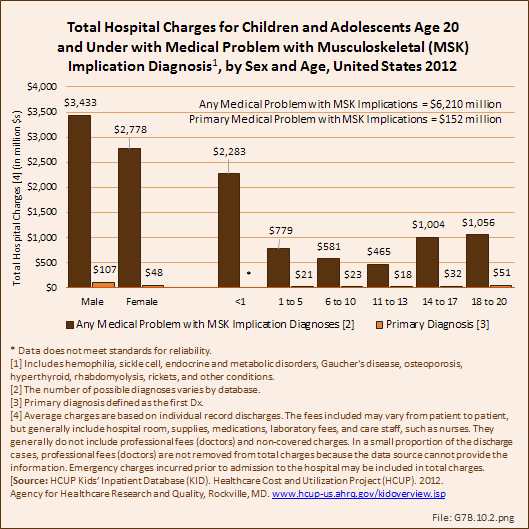
Musculoskeletal pain syndromes, including amplified musculoskeletal pain, juvenile primary fibromyalgia syndrome, reflex sympathetic dystrophy, benign hypermobility, and benign limb pains, are common diagnoses in the pediatric population. A systematic review examining the prevalence of chronic musculoskeletal pain found a range of prevalence rates between 4% and 40% in children. Rates were generally higher in girls and increased with age.1 It is estimated that 5% to 8% of new patients presenting to North American pediatric rheumatologists have a musculoskeletal pain syndrome.2
Amplified musculoskeletal pain and juvenile fibromyalgia syndrome are related conditions with the common feature of diffuse pain involving at least three major body parts for at least 3 months. Patients also typically have sleep disturbance and other somatic complaints, such as headaches and abdominal pain. Reflex sympathetic dystrophy (RSD), now also called complex regional pain syndrome (CRPS), is a form of amplified pain in which autonomic dysfunction develops in an extremity, often following injury or trauma. The affected limb becomes swollen and discolored and the area can be very painful with light touch (allodynia). The recommended treatment for these conditions includes restoring normal sleep patterns, a therapy program with a focus on exercise and desensitization, and cognitive behavioral therapy. Some patients require treatment in an in-patient setting.3
Benign limb pains, also sometimes referred to as “growing pains,” are most common in children age 2 to 5 years. Children with benign limb pains tend to complain of pain at night, often awaking from sleep due to pain. These symptoms tend to resolve with age. Benign hypermobility is diagnosed in patients who have hypermobile joints4, without an underlying connective disuse disorder. This condition is common, affecting 8% to 20% of White populations. Anterior knee pain and back pain are more common in hypermobile vs nonhypermobile individuals.2
Pain syndromes were diagnosed in more than 2.5 million children and adolescent health care visits in 2012, of which 66% (1.7 million) had a primary diagnosis of a pain syndrome. Less the 1% of children and adolescents with any pain syndrome diagnoses were hospitalized (20,800), while a tiny fraction (1,900) with a primary diagnosis had a hospital discharge. The majority of children and adolescents with a pain syndrome diagnosis were seen in physicians’ offices. (Reference Table 7.1.1 PDF [1] CSV [2] and Table 7.1.2 PDF [3] CSV [4])
Females were hospitalized with a pain syndrome diagnosis in slightly higher numbers than males, both for any diagnoses and as a primary diagnosis. Pain syndrome diagnoses increase as a contributing diagnosis in older children, but as a primary diagnosis age is not a factor.
Any diagnoses of pain syndrome accounted for just over 4% of hospitalizations for any musculoskeletal condition diagnosis, and 0.3% of all hospitalizations for any health care condition. Hospitalizations with a primary diagnosis pain syndrome were 0.4% of all musculoskeletal diagnoses and a tiny portion of hospitalizations for any health condition diagnosis. (Reference Table 7.11 PDF [32] CSV [33])
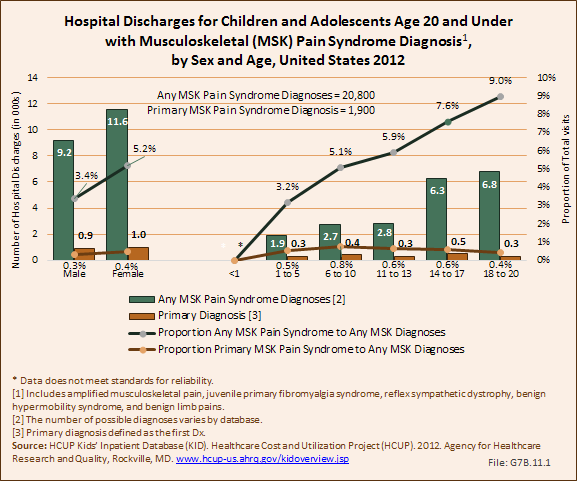
Total charges averaged $42,000 for a mean 5.6-day stay when children and adolescents were hospitalized with any diagnosis of a pain syndrome along with other medical conditions. With a primary pain syndrome diagnosis, the stay was shorter (3.1 days), and mean charges about half that of pain syndrome as a contributing condition ($22,900). Age and sex were not significant factors in length of hospital stay and average charges for a medical problem diagnosis. Total hospital charges for primary pain syndrome diagnosis discharges in 2012 were $43.4 million. (Reference Table 7.11 PDF [32] CSV [33])
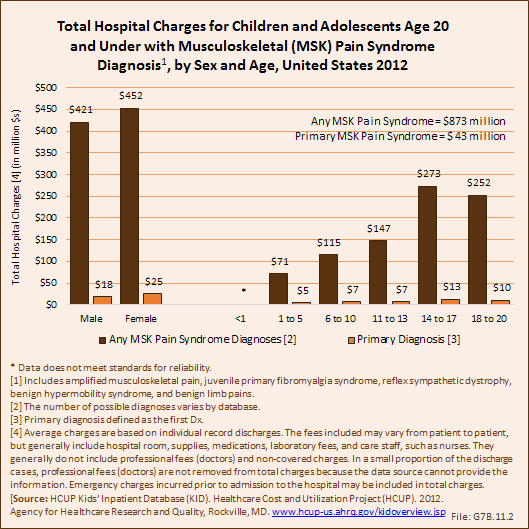
Links:
[1] https://bmus.latticegroup.com/docs/T7.1.1.pdf
[2] https://bmus.latticegroup.com/docs/T7.1.1.csv
[3] https://bmus.latticegroup.com/docs/T7.1.2.pdf
[4] https://bmus.latticegroup.com/docs/T7.1.2.csv
[5] https://bmus.latticegroup.com/docs/T7.2.pdf
[6] https://bmus.latticegroup.com/docs/T7.2.csv
[7] http://www.boneandjointburden.org/2014-report/viig0/children-adolescent-icd-9-cm-codes
[8] https://bmus.latticegroup.com/docs/T7.3.pdf
[9] https://bmus.latticegroup.com/docs/T7.3.csv
[10] https://bmus.latticegroup.com/docs/T7.4.pdf
[11] https://bmus.latticegroup.com/docs/T7.4.csv
[12] https://bmus.latticegroup.com/docs/T7.5.pdf
[13] https://bmus.latticegroup.com/docs/T7.5.csv
[14] https://bmus.latticegroup.com/docs/T7.6.pdf
[15] https://bmus.latticegroup.com/docs/T7.6.csv
[16] http://www.ncys.org/publications/2008-sports-participation-study.php
[17] http://www.physicalactivitycouncil.com/pdfs/current.pdf
[18] http://www.boneandjointburden.org/2013-report/research-funding-care-and-prevention/vii3a-0
[19] https://bmus.latticegroup.com/docs/T7.7.1.pdf
[20] https://bmus.latticegroup.com/docs/T7.7.1.csv
[21] https://bmus.latticegroup.com/docs/T7.7.2.pdf
[22] https://bmus.latticegroup.com/docs/T7.7.2.csv
[23] https://bmus.latticegroup.com/2014-report/ixac10/childhood-cancers
[24] https://bmus.latticegroup.com/docs/T7.8.pdf
[25] https://bmus.latticegroup.com/docs/T7.8.csv
[26] http://www.cdc.gov/arthritis/basics/childhood.htm
[27] https://bmus.latticegroup.com/docs/T7.9.pdf
[28] https://bmus.latticegroup.com/docs/T7.9.csv
[29] https://bmus.latticegroup.com/docs/T7.10.pdf
[30] https://bmus.latticegroup.com/docs/T7.10.csv
[31] http://www.stopchildhoodpain.org
[32] https://bmus.latticegroup.com/docs/T7.11.pdf
[33] https://bmus.latticegroup.com/docs/T7.11.csv